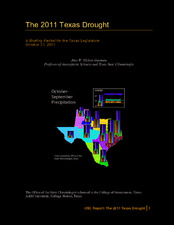| dc.description.abstract | The 2011 drought in Texas has been unprecedented in its intensity. The year 2010 had been
relatively wet across most of the state, except for extreme eastern Texas. Beginning in
October 2010, most of Texas experienced a relatively dry fall and winter, but the record dry
March 2011 brought widespread extreme drought conditions to the state. A record dry
March through May was followed by a record dry June through August, and the 12-month
rainfall total for October 2010 through September 2011 was far below the previous record
set in 1956. Average temperatures for June through August were over 2 °F above the
previous Texas record and were close to the warmest statewide summer temperatures ever
recorded in the United States.
As the drought intensified, the previous year’s relatively lush growth dried out, setting the
stage for spring wildfires. Conditions were so dry during the spring planting season across
much of the state that many crops never emerged from the ground. Continued dry weather
through the summer led to increasing hardship for ranchers, who generally saw very little
warm-season grass growth while stock tanks dried up. The record warm weather during the
summer in Texas was primarily a consequence of the lack of rainfall, but the heat and
resulting evaporation further depleted streamflow and reservoir levels. By early fall, trees in
central and eastern Texas were showing widespread mortality and dry and windy conditions
allowed forest fires to burn intensely and spread rapidly in Bastrop and elsewhere.
Twelve-month rainfall was driest on record across much of western, central, and southern
Texas, and many stations received less than 25% of their normal 12-month precipitation.
The area near, north, and east of Dallas was comparatively well off compared to the rest of
the state, but still endured serious drought conditions and record heat.
This drought has been the most intense one-year drought in Texas since at least 1895 when
statewide weather records begin, and though it is difficult to compare droughts of different
durations, it probably already ranks among the five worst droughts overall. The statewide
drought index value has surpassed all previous values, and it has been at least forty years
since anything close to the severity of the present drought has been experienced across
Texas.
Because of the return of La Niña conditions in the tropical Pacific, a second year of drought
in Texas is likely, which will result in continued drawdown of water supplies. Whether the
drought will end after two years or last three years or beyond is impossible to predict with
any certainty, but what is known is that Texas is in a period of enhanced drought
susceptibility due to global ocean temperature patterns and has been since at least the year
2000. The good news is that these global patterns tend to reverse themselves over time,
probably leading to an extended period of wetter weather for Texas, though this may not
happen for another three to fifteen years. Looking into the distant future, the safest bet is
that global temperatures will continue to increase, causing Texas droughts to be warmer and
more strongly affected by evaporation. | en |



